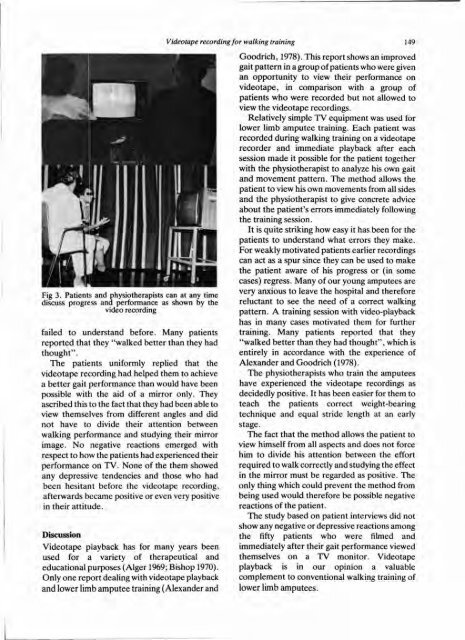View Complete Issue PDF
View Complete Issue PDF
View Complete Issue PDF
You also want an ePaper? Increase the reach of your titles
YUMPU automatically turns print PDFs into web optimized ePapers that Google loves.
Videotape recording for walking training 149<br />
Fig 3. Patients and physiotherapists can at any time<br />
discuss progress and performance as shown by the<br />
video recording<br />
failed to understand before. Many patients<br />
reported that they "walked better than they had<br />
thought".<br />
The patients uniformly replied that the<br />
videotape recording had helped them to achieve<br />
a better gait performance than would have been<br />
possible with the aid of a mirror only. They<br />
ascribed this to the fact that they had been able to<br />
view themselves from different angles and did<br />
not have to divide their attention between<br />
walking performance and studying their mirror<br />
image. No negative reactions emerged with<br />
respect to how the patients had experienced their<br />
performance on TV. None of the them showed<br />
any depressive tendencies and those who had<br />
been hesitant before the videotape recording,<br />
afterwards became positive or even very positive<br />
in their attitude.<br />
Discussion<br />
Videotape playback has for many years been<br />
used for a variety of therapeutical and<br />
educational purposes (Alger 1969; Bishop 1970).<br />
Only one report dealing with videotape playback<br />
and lower limb amputee training (Alexander and<br />
Goodrich, 1978). This report shows an improved<br />
gait pattern in a group of patients who were given<br />
an opportunity to view their performance on<br />
videotape, in comparison with a group of<br />
patients who were recorded but not allowed to<br />
view the videotape recordings.<br />
Relatively simple TV equipment was used for<br />
lower limb amputee training. Each patient was<br />
recorded during walking training on a videotape<br />
recorder and immediate playback after each<br />
session made it possible for the patient together<br />
with the physiotherapist to analyze his own gait<br />
and movement pattern. The method allows the<br />
patient to view his own movements from all sides<br />
and the physiotherapist to give concrete advice<br />
about the patient's errors immediately following<br />
the training session.<br />
It is quite striking how easy it has been for the<br />
patients to understand what errors they make.<br />
For weakly motivated patients earlier recordings<br />
can act as a spur since they can be used to make<br />
the patient aware of his progress or (in some<br />
cases) regress. Many of our young amputees are<br />
very anxious to leave the hospital and therefore<br />
reluctant to see the need of a correct walking<br />
pattern. A training session with video-playback<br />
has in many cases motivated them for further<br />
training. Many patients reported that they<br />
"walked better than they had thought", which is<br />
entirely in accordance with the experience of<br />
Alexander and Goodrich (1978).<br />
The physiotherapists who train the amputees<br />
have experienced the videotape recordings as<br />
decidedly positive. It has been easier for them to<br />
teach the patients correct weight-bearing<br />
technique and equal stride length at an early<br />
stage.<br />
The fact that the method allows the patient to<br />
view himself from all aspects and does not force<br />
him to divide his attention between the effort<br />
required to walk correctly and studying the effect<br />
in the mirror must be regarded as positive. The<br />
only thing which could prevent the method from<br />
being used would therefore be possible negative<br />
reactions of the patient.<br />
The study based on patient interviews did not<br />
show any negative or depressive reactions among<br />
the fifty patients who were filmed and<br />
immediately after their gait performance viewed<br />
themselves on a TV monitor. Videotape<br />
playback is in our opinion a valuable<br />
complement to conventional walking training of<br />
lower limb amputees.

















